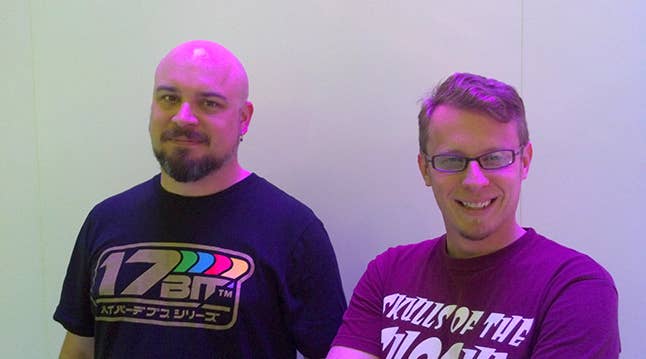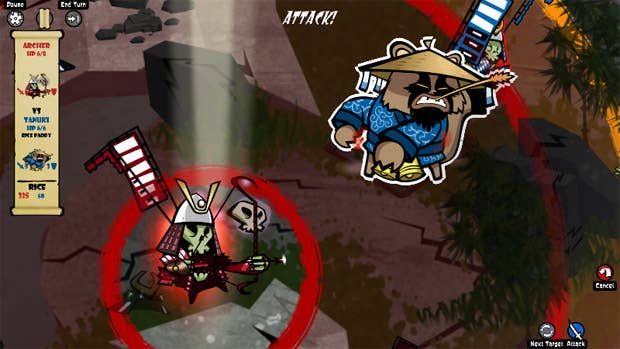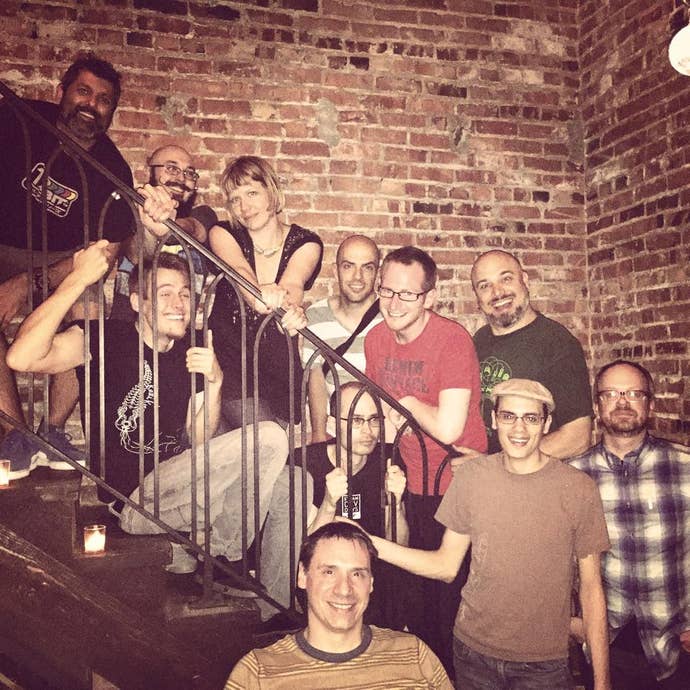17-Bit's Long Road to Finishing Galak-Z
From bugs to communication problems, 17-Bit's Jake Kazdal reflects on the lessons learned from the two-year process of building Galak-Z.
This article first appeared on USgamer, a partner publication of VG247. Some content, such as this article, has been migrated to VG247 for posterity after USgamer's closure - but it has not been edited or further vetted by the VG247 team.
Any artist can relate to Jake Kazdal's mood in the days leading up to the release of Galak-Z. 17-Bit's co-founder was in a state of nervous excitement, both confident that he and his team had created a strong game and anxious over how it would be received.
"We need it do well," he told me matter-of-factly as we sat down to talk at his studio in Kyoto, a comfortable two-floor apartment converted into a work space complete with a tatami mat demo room.
It was nearing mid-July and the team was in the process of putting the finishing touches on Galak-Z, the shoot 'em up that had at that point been in development. The time crunch was apparent. When I spoke with Kazdal, the team had only just locked the framerate at above 30 frames per second. When I got a build a few weeks later, the team was still pushing out last second updates.
Galak-Z is out now, and it has been met with a generally positive reception, but it wasn't easy getting to that point. As Kazdal told me during our talk, "I thought we would do much better [with Galak-Z] because we f***** up so many different ways in Skulls of Shogun. I was like, 'We can't possibly f*** up that much again.'"
He sighed, "We did."
Always Six Months Away
The first thing you have to understand about Kazdal is that he's an artist and a gamer first. He's been in the gaming industry since he was a teenager, his host of jobs including a stint as a Nintendo Game Counselor and working with Tetsuya Mizuguchi on Rez. He's full of stories that he'll just casually toss out, like when he was working as a Game Counselor and someone brought out the North American version of the Super Nintendo for the first time.
"We all thought it was really ugly," he told me. Kazdal much prefers the look of the original Super Famicom. Being an artist, aesthetics matter to him.

Over the years Kazdal has worked in art and animation for Sega, EA, and Zombie Studios, his credits including Boom Blox and Space Channel 5. He alternately describes game development as a "wild jungle" and a "wild west of adventure," which speaks to the energy with which he approaches his passion. Never one to hew to a particular set of rules or a template, Kazdal says of his philosophy on development, "When I start a project, we don't really know where we're going other than that I have a feeling in my head of what I want it to feel like and what it's going to be, but we get off the beaten path and try different things out. To me, that's really the fun of game development."
Kazdal made the leap into indie development in 2009. After working on the production design and art for games he described as "gritty dark alleys and spaceships and all of this hardcore sci-fi stuff," he wanted to do something "fun and cute." With the help of Borut Pfeifer, who worked as a programmer at EA, he conceived of a strategy for the iPhone that would later become Skulls of the Shogun. Though it was only a side project at first, it eventually snowballed to the point that he and his partners signed deals with Microsoft for versions on Windows Phone, Xbox, and Windows 8.
"We hired more staff and pretty soon we had actual money and a contract," Kazdal remembered. "We were going to shows and the game was always 6 months away from being done and it just migrated with us for what ended up being three and a half years."
Design was not a problem for either Skulls of the Shogun or Galak-Z. Both were "super strong from the get-go" in terms of raw gameplay, Kazdal says. "It's not like, 'What are we going to do?' No. It's already fun. It's already awesome. We just need to make more and make it better."
The real struggle for Skulls of the Shogun was in developing it for multiple platforms. As Kazdal told Polygon in 2012, "It's been difficult just because this is all brand-new stuff. So a lot of the development pipeline stuff wasn't in place; devkits [development hardware units] are really hard to come by."

Kazdal and company also came to regret signing on with Microsoft. In a 2013 interview with RPS, Pfeifer characterized it as a 'deal with the devil.' Their biggest mistake, he said, was "thinking in 2008 terms" and assuming that Xbox Live Arcade was the "gateway to indie success." It wasn't long before they ran into problems with long ceritification times and bureacracy, as well as issues with being paid on time.
Skulls of the Shogun finally launched in 2013, earning strong reviews but struggling to rack up sales. Aside from the struggles suffered by platforms like Windows 8, 17-bit had a problem with messaging. As Pfeifer later told Gamasutra, they ran into trouble in part because casual players were put off by the game's strategic systems, while hardcore strategy fans saw it as too cartoony.
Ultimately, Skulls of the Shogun was a game 17-Bit could be proud of, but it had also been a very long road. Kazdal and company vowed to take it as a learning experience. Their next project, Galak-Z, would launch on PlayStation 4, where they could take advantage of Sony's prioritization of indie development. For maximum flexibility, they would use the Unity Engine. With luck, development would go much more smoothly and issues with certification would be a thing of the past.
It was around this time that Kazdal decided to move back to Japan to open up a branch in Kyoto. Kazdal was extremely fond of Japan, having gone to school in Kobe and worked with Mizuguchi at Sega of Japan. He was ready to go back. "There's a big dedicated, independent foreigner scene [in Kyoto]. There's also Japanese game developers and stuff like that. So I can get my Japanese culture and hang out with my Japanese friends. I can also blow off steam and talk about current events and modern gaming stuff with all of these foreigners too. It's the perfect mix here," he says. "And we want to build up our studio to be half Japanese, half non-Japanese. So it was just the perfect place for us."

What Kazdal didn't reckon with, though, was the communication issues that would develop over the course of the project. With more than half of 17-Bit's development team still residing in Seattle, days became bogged down in emails and Skype meetings.
"Game development is hell on a good day. It's so hard on a perfect situation. Throwing in unnecessary massive gaps in communication and intention and communication by email is always bullshit. Sh*t comes across as angry when it's not," Kazdal says. "People get really defensive for no reason. It's just a f****** disaster. I just swear to god I am so excited about the idea of having my whole team back here in one room."
Technical issues crept in as well. Galak-Z looked quite rough over the course of much of its development, with a framerate that would frequently fall into the teens - completely unacceptable to Kazdal. With Skulls of the Shogun having been only a modest success, pressure mounted to make Galak-Z a runaway hit.
And then there was the problem of stamping out bugs. When Polygon's Arthur Gies recently took to Twitter to rail against games being released as work is being done on them "until literally the last minute," Kazdal jumped in with his own perspective.
Indeed, he would know. When Galak-Z launched last week, it was with an unexpected showstopping bug that the team had thought resolved months before. They wound up working around the clock to push out a large launch patch to deal with the bugs as well as the still niggling issues with the framerate. To their credit, it did indeed resolve most of the problems, but the fact that it was needed at all speaks to the rather intense challenges 17-Bit faced in developing Galak-Z.
As for Kazdal, he discovered over the course of the project that it's one thing to make a really good, attractive game, but it's another thing entirely to be a manager.
When Artists Become Managers
One thing that's clear about Kazdal is that he has a very clear vision for his games, and he's uncompromising in making it happen. But it's another thing to communicate that vision. With 17-Bit growing to nine team members spread across two continents, Kazdal faced the challenge of trying to explain what he wanted over Skype, then trying to give detailed feedback when it did come out the way he expected. His frustration over the process is evident when he talks about it.
He's frank in evaluating how he needs to improve as a manager. "As the creative director, project director and art director, the game is very clear in my head, which is great, but I need to be better at communicating the whole vision to the whole team earlier and more often," he says. "So I'm going to start, as much as I shudder at the thought, actual game design documents, which I've always thought were a f**king relic and they're stupid and they get outdated immediately and then no one ever looks at them again... You have to keep up with them. So I'm going to make them not abstract, but tenements of this title.

Kazdal also plans to use stubs more - programming subsitutes that will allow him to use test his game's code without having to create the art or UI instead. "You can put a big nasty art sign that says, 'Something cool is going to go here, the menu is going to go here or whatever,' but stub it in, get used to the flow, know what you need to get to. That way you're not like, 'We're almost done. Oh sh*t! What about that thing that we forgot that we have to do?' How do we f*** this up so hard? Because you're so focused every day on what you're working on, putting out fires and freaking out, this thing over here, if you don't look over here, you just forget all about it."
It's evident that the hard lessons of independent development can be painful, even for veterans like Kazdal who have been in and around the industry for 20 years or more. And with the attention and detail that 17-Bit puts into their games - attractive animation, cutscenes, and smart and varied enemies - the challenges are multiplied. Still, Kazdal isn't one to cut corners. "Any of these really polished games, you can't rush it out, get it out. A lot of this smaller scale indie stuff is like a year or a year-and-a-half, but it's more like a sketch than a painting. And that's fine. I'm not saying that all games have to be this fully realized thing, but I think when you play these really high-end Indies that are really genre-defining and really nice and amazing, they took a long time to cook. It just f****** takes a long time."
For the most part, 17-Bit's hard work seems to have paid off. Galak-Z has been well-received, holding steady at 84 on Metacritic. There's a buzz around Galak-Z that wasn't as noticeable around Skulls of the Shogun.
Regardless of how well it sells, though, Kazdal will keep striving to make the kind of games he loves. This time, it may even go as smoothly as he hopes.


